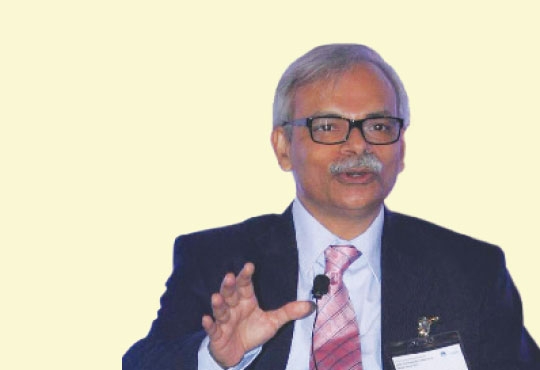
Top 5 Must-Haves to Make Smart City a Success in India
Ankush Tiwari, CTO, Mobiliya Technologies | Wednesday, 15 February 2017, 06:34 IST
 If the government’s recent Smart City initiative is anything to go by, we could soon see a dramatic shift in the way we go about our daily lives. The Government’s recent Smart City Initiative envisages transforming 100 cities (Phase I) into efficient, connected areas that promise enhanced lifestyles, better safety and more engaged community experience to its citizens. A seamless experience powered by the Internet of Things (IoT) that promises to transform our lives, forever.
If the government’s recent Smart City initiative is anything to go by, we could soon see a dramatic shift in the way we go about our daily lives. The Government’s recent Smart City Initiative envisages transforming 100 cities (Phase I) into efficient, connected areas that promise enhanced lifestyles, better safety and more engaged community experience to its citizens. A seamless experience powered by the Internet of Things (IoT) that promises to transform our lives, forever.
Riding on the back of the government’s flagship Digital India mission, the Smart City venture focuses on leveraging digital technologies to control and manage traffic systems, street lighting, emergency services, disaster relief, roads, railways, and energy efficient buildings. For tech drivers, it means converging citizens, government, and businesses on a single platform.
However, while the excitement about the new program and immense possibilities is palpable, the success of the Smart City initiative depends on certain key factors:
1. Security: Of Devices, Network & People: The sheer number of connected devices in a proposed smart city initiative makes security the toughest challenge. In contrast to the typical laptops, tablets or smartphones, IoT devices can come in any form, shape, and size. In a Smart City scenario, a lot of citizen data will move around across different portals, creating the need for a fool-proof data network. With the upcoming developments – such as digital lockers, identity protection needs to be a priority. Even companies like Google and Microsoft have faced the ire of citizens for not being able to provide optimum security of personal data. The last thing public officials want is nefarious groups hacking into the city’s public services and tampering with the train timings or bus routes, leading to disastrous consequences. Thus, it is critical to have integrated cloud-based security solutions that are connected to the public network, scans it for threats and malware and immediately blocks suspicious devices and sends alerts to the concerned owners or authorities.
2. The success of Aadhaar: For any smart city, an information backbone is required where every citizen has an identity that’s identified by the system. An Aadhaar identity is important as it offers unique identification for all citizens and one that will integrate with all systems in a smart city.
A smart city landscape will comprise of a multitude of platforms, devices, and applications running parallel – for lighting, traffic management, mass transit, waste management etc. For municipal authorities to truly be able to manage these systems efficiently, a centralized IT infrastructure is critical. Public officers must be able to check current traffic situation across major junctions, detect hotspots for possible traffic jams based on road sensors tracking the flow of traffic and immediately manage the traffic signals accordingly, all from a single interface.
A single integrated channel which communicates with millions of disparate systems, protocols and devices forms the backbone of a smart city system. The Aadhaar platform in a smart city would help all civic systems and service providers authenticate the identity of residents electronically, in a safe and quick manner, making delivery of services more effective and efficient.
3. A Centralized Control Room: Dealing with big data and making the best use of analytics and dashboards will be crucial. Different civic bodies like police, municipal corporations and fire brigades will have to work together through a Master Control Room to have the best technological tools (like analytics) to improve the quality of life and service within a Smart City.
4. Citizen Participation App: For citizens to truly enjoy the smart and connected experience, it is important to encourage maximum citizen participation. This can be done by introducing several smart city apps – like, for e.g., an app that provides details to taxi drivers the total number of passengers from an upcoming train and how many of them will need a taxi as against those having their own private pick-ups. A higher number of people needing a cab/taxi service would mean that a trip to the rail head or metro station would be more promising for a taxi driver/cab owner.
5. Device Ecosystem & Make in India: And finally, the smart city transformation is possible only when citizens and government bodies have access to cheaper devices and sensors. Under the Make in India initiative, the government can give a big boost by manufacturing low-cost devices and sensors and promote the overall device ecosystem to power smart cities.
Several European, as well as US urban centers, have already gained significant momentum in their smart city initiatives. With India poised to become the second largest economy in the world in the next ten years, it is never too soon for the governments and public authorities across the country to truly step up the plate and create a strong IoT-driven infrastructure that will deliver new value to your city.
CIO Viewpoint
Some Other Aspect of Solution Selection
By Shiv Shankar Datta, Head IT, FCA Fiat Chrysler Automobiles
Technology - The World of Iron and Steel
By Ashok Kumar, CTO,Tata Steel
Top 5 Must-Haves to Make Smart City a Success...
By Ankush Tiwari, CTO, Mobiliya Technologies
CXO Insights
Design as a Service: Done Right
By By Debprotim Roy, Founder & CEO, Canvs
Engineering Discipline is Catalytic for Overall...
By Pradeep Vajram, CEO, SmartPlay Technologies
Should a CIO Invest in Product Development?



.jpg)
.jpg)





